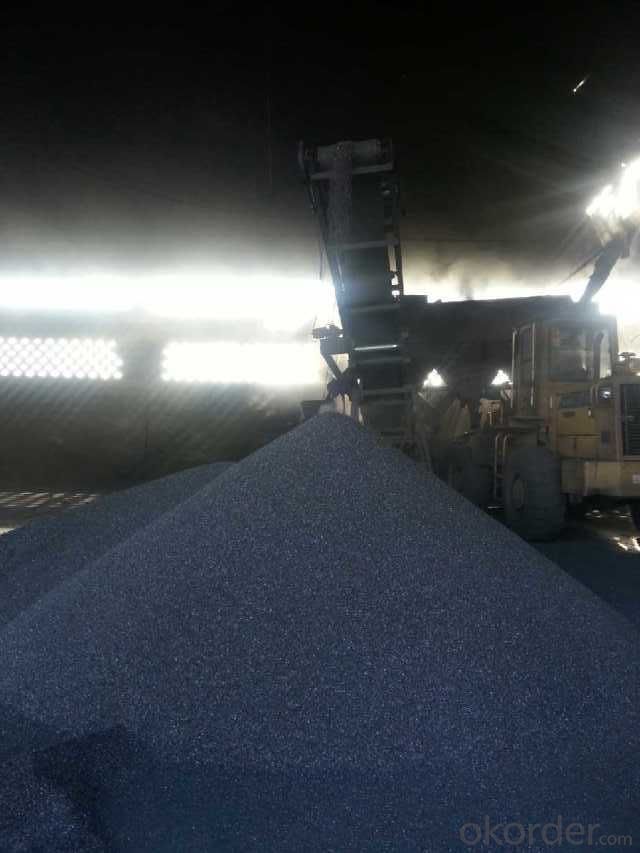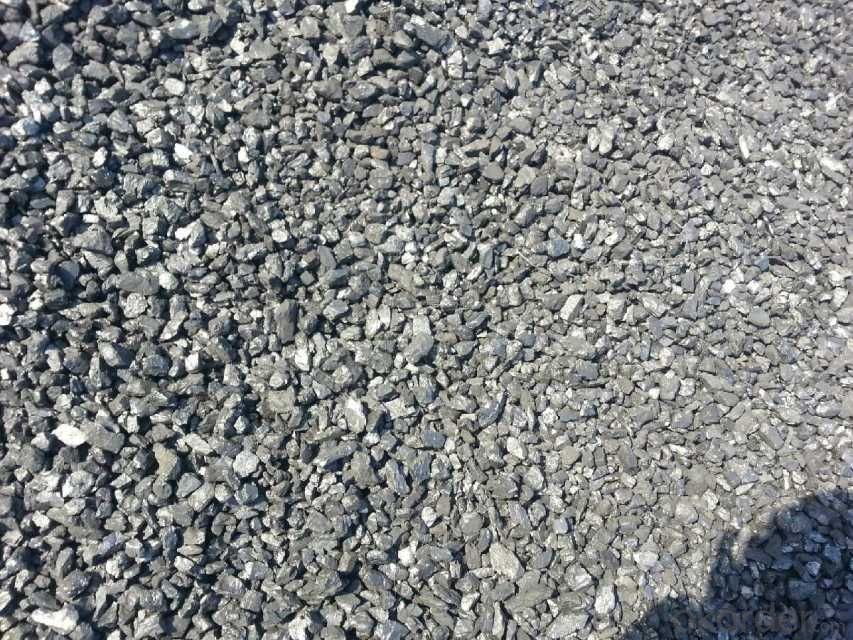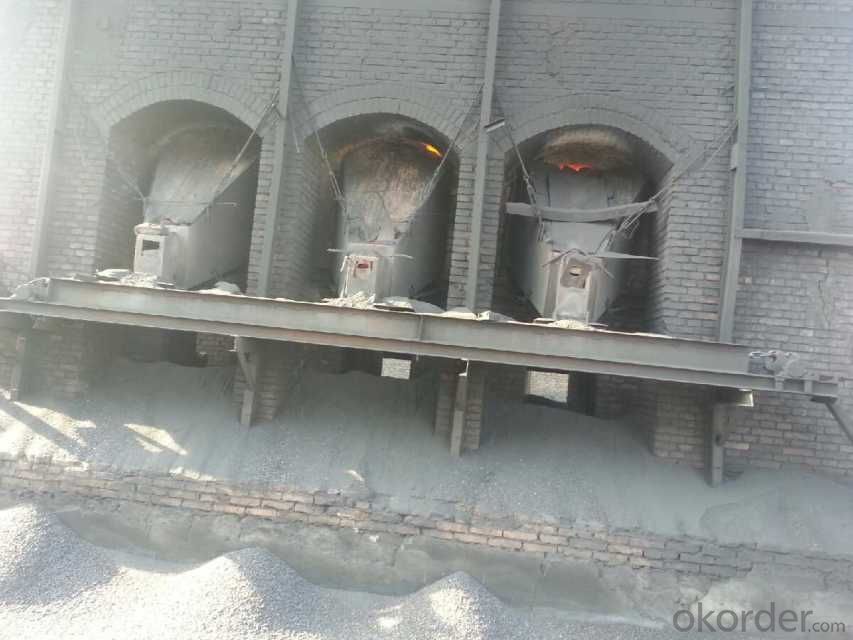FC92 Calcined Anthracite With National Standard
- Loading Port:
- Tianjin
- Payment Terms:
- TT OR LC
- Min Order Qty:
- 0 m.t.
- Supply Capability:
- 100000 m.t./month
OKorder Service Pledge
OKorder Financial Service
You Might Also Like
Packaging & Delivery
Packaging Detail: | 25kgs/50kgs/1ton per bag or as buyer's request |
Delivery Detail: | Within 20 days |
Specifications
Calcined Anthracite
Fixed carbon: 90%-95%
S: 0.5% max
Size: 0-3. 3-5.3-15 or as request
PARAMETER UNIT GUARANTEE VALUE | |||||
F.C.% | 95MIN | 94MIN | 93MIN | 92MIN | 90MIN |
ASH % | 4MAX | 5MAX | 6MAX | 7MAX | 8MAX |
V.M.% | 1 MAX | 1MAX | 1.5MAX | 1.5MAX | 1.5MAX |
SULFUR % | 0.5MAX | 0.5MAX | 0.5MAX | 0.5MAX | 0.5MAX |
MOISTURE % | 0.5MAX | 0.5MAX | 0.5MAX | 0.5MAX | 0.5MAX |
Feature
All of our goods are made in the best quality of world famous Tianjin. All of our products are with High carbon, Low ash, low sulphur, Low Moisture.
Usage
The Calcined Anthracite Coal/Gas Calcined Anthracite Coal/Carbon Raiser is mainly used in steelmaking in electrical stove, screening water, shipbuilding sandblast to remove rust. It can reduce the cost of steelmaking effectively by replacing the traditional petroleum coke of carburant.Also can improve the Carbon content in steel-melting and Ductile iron foundry.
Size can be adjusted based on buyer's request.
Pictures of Calcined Anthracite



- Q:What is the basic principle of carbon fourteen detection?
- Carbon fourteenCarbon fourteen, a radioactive isotope of carbon, was first discovered in 1940. It is produced by hitting twelve carbon atoms in the air through cosmic rays. Its half-life is about 5730 years, the decay is beta decay, and the carbon 14 atoms are converted to nitrogen atoms. Since its half-life is 5730 years, and carbon is one of the elements of organic matter, we can infer its age by the 14 component of the residual carbon in the dying organism. When living in the biological, because need to breathe, the carbon content of 14 in its body is about the same, the organisms die will stop breathing, at this time the carbon 14 in the body began to decrease. Since the proportion of carbon isotopes in nature is always stable, one can estimate the approximate age of an object by measuring its carbon 14 content. This method is called carbon dating. Other commonly used methods include potassium argon measurements, potassium argon measurements, thermoluminescence measurements, and others;
- Q:How to distinguish carbon rods to identify carbon fishing rods?
- I'm also waiting to learn! It seems all very busy, the masters are not on-line
- Q:How does carbon impact the availability of sustainable agriculture practices?
- Carbon impacts the availability of sustainable agriculture practices in several ways. Firstly, carbon emissions from various human activities, such as burning fossil fuels and deforestation, contribute to climate change. This change in climate patterns can lead to extreme weather events like droughts, floods, and heatwaves, which can negatively affect agricultural productivity. Furthermore, excessive carbon in the atmosphere contributes to the greenhouse effect, trapping heat and raising global temperatures. This rise in temperature can disrupt natural ecosystems and reduce the availability of arable land for agriculture. It can also alter precipitation patterns, leading to water scarcity or excessive rainfall, both of which can hinder sustainable agriculture practices. Carbon also plays a role in soil health and fertility. Excessive carbon dioxide in the atmosphere can be absorbed by soils, leading to increased soil acidity. This acidification can lower soil pH levels, making it difficult for crops to absorb essential nutrients. Additionally, high carbon levels can impact soil microorganisms, which are crucial for nutrient cycling and maintaining soil fertility. However, carbon can also have positive impacts on sustainable agriculture practices. Carbon sequestration, the process of capturing and storing carbon dioxide from the atmosphere, can be utilized to enhance soil health. Practices like planting cover crops, adopting agroforestry systems, and implementing no-till farming techniques can help sequester carbon in the soil, improving its fertility and resilience. This, in turn, promotes sustainable agriculture by increasing crop yields, reducing the need for synthetic fertilizers, and enhancing soil water-holding capacity. In conclusion, carbon emissions and their effects on climate change and soil health significantly impact the availability of sustainable agriculture practices. Mitigating carbon emissions and adopting practices that sequester carbon are crucial for ensuring a sustainable and resilient agricultural system in the face of climate change.
- Q:How is carbon used in the production of ceramics?
- Carbon is used in the production of ceramics as a key component in the creation of carbon-based materials, such as carbon fibers or carbon nanotubes, which can be incorporated into ceramic matrices to enhance their mechanical properties, electrical conductivity, and thermal stability. Additionally, carbon can also be utilized as a reducing agent in certain ceramic processes, such as the production of silicon carbide, where it reacts with oxygen to remove impurities and stabilize the ceramic structure.
- Q:How does a kebab cook at home?
- Do you have long fire sticks in your house?...... Yes, just a carbon and burn it over the gas stove...... If not, apply a little oil underneath......Burn, put carbon on the top, pay attention to leave the gap, do not suppress it.
- Q:How do you make your own carbon fiber bar?Know. ID is how to make? Don't copy anything that has nothing to do with it
- 3. carbon fiber product form and manufacturing process carbon fiber has four kinds of products: fiber, fabric, prepreg, and chopped fiber. Cloth refers to fabric made from carbon fibers. Prepreg is a product in which carbon fibers are aligned in one direction and impregnated with carbon fibers or fabrics to form sheets. A staple fiber is a short fiber. These products, together with resins, will form carbon fiber reinforced plastics (CFRP) at different ratios. The resin is attached to the fiber and can be made into a pressure vessel and roll, which is wound around a core and then plasticized or hardened. This method is called "winding forming method"". Put the cloth into a model, and then soak it with resin. It can also be the body part of the production card. This is the "method of resin transfer molding (RTM)". The manufacture of aircraft elements is made by heating, pressing and plasticizing preforms in a autoclave. A strand of prepreg is wrapped around a core and heated and plasticized. This is known as the sheet winding method, which can be used to make a golf club, a fishing rod. The short silk is mixed with resin to form a mixture, which can be used to produce mountain machine components and other products after processing. In the past, prepreg was the most widely used form of carbon fiber, fabricated by sheet winding in a reactor. Recently, however, with the development of new industrial applications, filament winding, blending and other methods of prefabrication have been developed more widely. The use of molding such as RTM has enabled manufacturers to make larger products more efficiently. The combination of carbon fiber with the most suitable resin and prefabrication process makes the application of carbon fiber more attractive.
- Q:How does carbon dioxide affect the Earth's climate?
- Carbon dioxide (CO2) is a greenhouse gas that plays a significant role in affecting the Earth's climate. When released into the atmosphere through natural and human activities such as deforestation, burning fossil fuels, and industrial processes, carbon dioxide traps heat from the sun and prevents it from escaping back into space. This process is commonly known as the greenhouse effect. The accumulation of carbon dioxide in the atmosphere leads to an increase in global temperatures, resulting in climate change. As CO2 levels rise, more heat is trapped, causing the Earth's average temperature to increase over time. This phenomenon is known as global warming. The consequences of increased carbon dioxide levels and subsequent climate change are far-reaching. Rising temperatures lead to the melting of glaciers and polar ice caps, which contribute to sea-level rise. This can result in coastal flooding, displacement of communities, and loss of biodiversity. Furthermore, altered weather patterns, including more frequent and intense heatwaves, droughts, and extreme weather events such as hurricanes and storms, are also linked to increased carbon dioxide levels. These events can have devastating impacts on ecosystems, agriculture, and human settlements. Moreover, elevated CO2 levels also affect the ocean's chemistry. As the oceans absorb carbon dioxide from the atmosphere, they become more acidic, a process known as ocean acidification. This poses a threat to marine life, particularly organisms with calcium carbonate shells, such as corals and shellfish. To mitigate the impacts of carbon dioxide on the Earth's climate, reducing greenhouse gas emissions is crucial. This can be achieved through transitioning to renewable energy sources, improving energy efficiency, promoting sustainable land use practices, and adopting cleaner technologies. Additionally, initiatives such as afforestation and reforestation can help absorb CO2 from the atmosphere, acting as carbon sinks. Addressing the issue of carbon dioxide and its impact on the Earth's climate is essential to safeguarding the planet's ecosystems, biodiversity, and human societies. By reducing carbon emissions, we can mitigate the effects of climate change and work towards a more sustainable future.
- Q:Today in the market to buy Yuba, instructions have such a word that I don't understand, please master Zhijiao: carbon fiber after energized carbon molecule formation of Brown movement, this movement can be effective in most of the electrical energy into the far infrared.
- They are the transition of vibrational levels or rotational levels under conditions of carbon energization. All molecules are doing irregular movements, for example, there is a bond between two molecules, equivalent to a spring connecting two balls connected to two balls, they vibrate, the frequency is v.
- Q:How does carbon cycle through the environment?
- The carbon cycle is a natural process through which carbon is constantly recycled and exchanged between the atmosphere, land, and ocean. It begins with carbon dioxide (CO2) being absorbed by plants through photosynthesis, converting it into organic compounds. These plants are then consumed by animals, transferring carbon up the food chain. When plants and animals die, their organic matter decomposes, releasing carbon back into the atmosphere as CO2. Additionally, some carbon is stored in the form of fossil fuels, such as coal and oil, which are released through human activities like burning fossil fuels and deforestation. Ultimately, carbon is continually cycled through the environment, balancing the levels of CO2 in the atmosphere and supporting life on Earth.
- Q:Will long-term use of carbon alloy chopsticks cause cancer?
- Do chopsticks also cause cancer? Experts say, should not use too long, 3 to 6 months that change, pay attention to chopsticks material selection, use and maintenance. Have you noticed how often the chopsticks are changed at home? Recently, a news about the need for regular replacement of chopsticks, attracted the attention of Internet users. According to reports, hidden in the small groove in the chopsticks bacteria, may cause dysentery, gastroenteritis and other diseases, it is recommended that the public, chopsticks should be replaced at regular intervals of 3~6 months. This makes many people surprised, "used so many years chopsticks, do not know!"." Yesterday morning, in the south near Xi'an Renrenle supermarket shopping public Ms. Hao said. Subsequently, a random survey of 20 members of the public, of which 4 people said that in the six months of internal moving or kitchen renovation and replaced chopsticks. While the other 16 citizens, the number of chopsticks used in the home was 1~3 years. Especially for families with old people, chopsticks are updated more slowly. "The old man can't bear to throw it. He can't help it. Every time he comes to the restaurant, the chopsticks are not enough."." Liu said the public. In this regard, yesterday, director of the Xi'an Municipal Hospital of traditional Chinese Medicine Department of Gastroenterology physician Huang Yahui said, if the wood and bamboo chopsticks used for a long time, it is easy to breed bacteria sawdust loose.
1. Manufacturer Overview |
|
|---|---|
| Location | |
| Year Established | |
| Annual Output Value | |
| Main Markets | |
| Company Certifications | |
2. Manufacturer Certificates |
|
|---|---|
| a) Certification Name | |
| Range | |
| Reference | |
| Validity Period | |
3. Manufacturer Capability |
|
|---|---|
| a)Trade Capacity | |
| Nearest Port | |
| Export Percentage | |
| No.of Employees in Trade Department | |
| Language Spoken: | |
| b)Factory Information | |
| Factory Size: | |
| No. of Production Lines | |
| Contract Manufacturing | |
| Product Price Range | |
Send your message to us
FC92 Calcined Anthracite With National Standard
- Loading Port:
- Tianjin
- Payment Terms:
- TT OR LC
- Min Order Qty:
- 0 m.t.
- Supply Capability:
- 100000 m.t./month
OKorder Service Pledge
OKorder Financial Service
Similar products
New products
Hot products






























